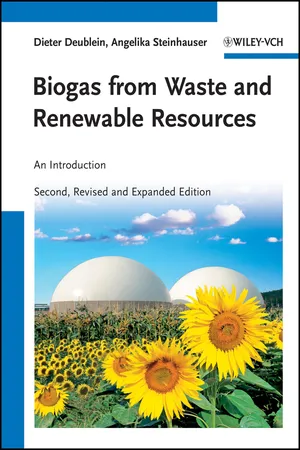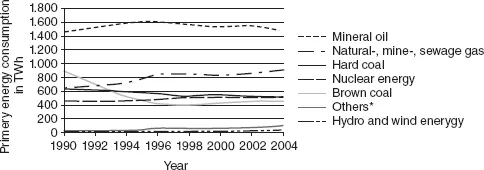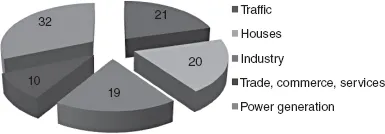![]()
Part One
Potential and History
General Thoughts about Energy Supply
Human beings are the only animals with the ability to ignite and use a fire. This advantage has been important for the growth of humankind, particularly during the past few decades, when the rapid rate of innovation in industry was especially facilitated by the immense richness of oil. Today, thousands of oil platforms exist globally, which provide the oil for about 50 000 kWh of energy per year. Yearly, around US$10 bn are spent in drilling for new oilfields to secure the supply of oil and hence the basis for industrial growth in the future.
However, as with all fossil resources, the quantity of oil is limited and will not last forever. For sure there will be a time when all the existing accessible oil fields will have been exploited. What is then going to happen to humankind?
May the same occur as is observed in Nature? Not only in animals but also in plants there are sudden “explosions of populations.” Such growth naturally stops, however, as soon as a source of life runs dry. The organisms start to suffer from deficiency symptoms and become dominated or eaten by stronger organisms.
How will human beings generate energy when all the oil resources that we benefit from today have been fully consumed? There is as yet no clear answer to this question. But regardless of what the answer may be, it is clear that the humankind will always want to continue to build huge inventories of energy. With the declining quantity of fossil fuels, it is critical today to focus on sustained economic use of existing limited resources and on identifying new technologies and renewable resources, for example, biomass, for future energy supply.
![]()
1
Energy Supply–Today and in the Future
Today, globally most energy is provided by burning oil [1]. Only a very small percentage is generated by nuclear power plants, and the contribution of energy from renewable resources is almost negligible. However, this will change with increases in the price of oil.
In the future, countries may use different technologies, depending on their climatic and geographic location. Germany refrains from using nuclear power plants as a source of energy, which makes Germany one of the leading countries in the development of technologies for alternative and renewable energy sources.
1.1 Primary Energy Sources
In general, primary energy sources are classified as follows:
Fossil energy sources: Hard coal, brown coal, petroleum, natural gas, oil shale, tar sand, gas hydrate
Renewable energy sources: Water, sun, wind, geothermal heat, tides, biomass
Nuclear fuels
These primary energy sources follow so-called “life cycles” as shown in Figure 1.1.
Until the late 19th century, wood, the traditional biomass, was the only primary energy source used for cooking and heating. This ended when wood was replaced by hard coal, an epoch which lasted about 75 years. This was followed in the late 1950s by the continuously increasing use of petroleum and natural gas. Around 1950, nuclear power technology was industrialized for the first time, but it never became truly accepted. For some years now, this technology has remained stagnant and has not expanded because of still unresolved issues such as the storage of the radioactive waste and the risk of explosion of a reactor. This leaves “renewable energies,” showing the greatest potential for securing the availability of energy in the future.
As an example, the total consumption of primary energy in Germany is about 4100 TWh a−1, which has been provided by the use of different primary energy sources, shown in Figure 1.1. The primary energy source used during the past few years in Germany was mainly mineral oil (Figure 1.2). In the early 1990s, a significant part of energy in East Germany was also generated by processing brown coal. After the German reunification, however, the mining of brown coal was stopped because of the great environmental damage it was causing. After this, the consumption of energy provided by hard coal remained almost static, whereas the energy from natural gas, mine gas, or sewage gas increased strongly to make up for that previously provided by brown coal. The use of renewable energy has been almost static during recent years, with a very slight, although consistent, upward trend.
Consumers using primary energy are shown in Figure 1.3. This pie chart shows that the traffic sector consumes 21% of the primary energy, which is even more than industry (19%). In fact, the amount of energy supplied to industry is decreasing, and increasing amounts go to traffic. This is explained by the current trend towards a society with a high number of cars per family, leading to a high demand for petrol, a secondary energy source of petroleum.
1.2 Secondary Energy Sources
Secondary energy sources are defined as products that have been produced by transforming primary energy carriers into higher quality products by applying processes such as refining, fermentation, mechanical treatment, or burning in power stations:
Products derived from coal: Coke, briquettes
Products derived from petroleum: Petrol, fuel oil, town gas, refinery gas
Products derived from renewable resources: Biogas, landfill gas, pyrolysis gas.
The secondary energy sources are converted into end-point energy.
1.3 End-Point Energy Sources
The end-point energy is the energy provided in the form of, for example, district heating, wood pellets, and electricity for the final users. In Germany, for example, the consumption of end-point energy is about 2600 TWh a−1. It is important to emphasize that only electricity and not gas is defined as end-point energy since gas is the energy source from which electricity is derived.
Usually the amount of end-point energy consumed is used for calculation purposes and is taken as a base to reflect energy balances.
1.4 Effective Energy
Only about 50% of the end-point energy, equivalent to one-third of the primary energy, is effective energy which is actually used by customers in form of heating, light, processing, motion, and communication. As an example, in Germany only 1400 TWh a−1 of energy is effectively used. About 570 TW a−1 of this energy is actually electrical energy.
![]()
2
Energy Supply in the Future–Scenarios
Shell International [4] has published a projection for different energy sources for the years from 1990 up to 2100 (Figure 2.1). Assuming the “Sustainable Growth” scenar...



